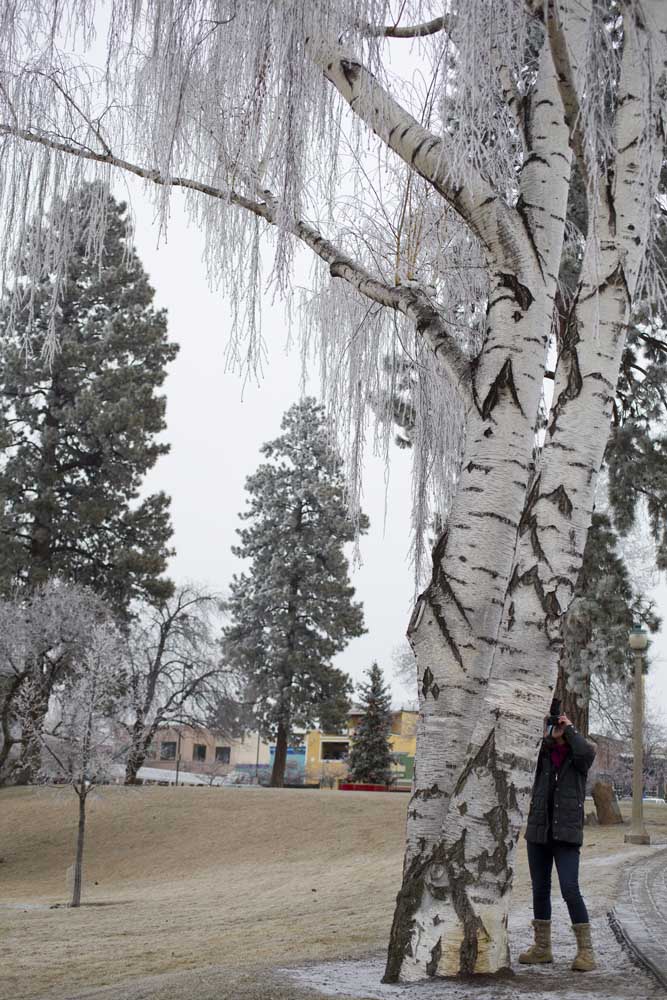An ice storm is coming. Here’s what that means.
Published 8:27 am Friday, January 3, 2025

- Freezing fog covering the branches of a tree in Drake Park.
When it comes to winter storms, ice can be particularly hazardous. Not only is freezing rain challenging to forecast, but ice storms can wreak havoc on electrical infrastructure and vegetation, knocking power out for weeks and leaving roadways impassible. Travel becomes dangerous if not impossible, with roads becoming ice rinks.
Freezing rain is exactly what it sounds like — rain that falls as a liquid and freezes on the ground. It coats everything in a slick glaze, sometimes accreting more than an inch thick. (Meteorologists often use the term accrete because ice accrues in layers — it doesn’t just pile up and accumulate like snow.) It takes only half an inch of freezing rain to weigh down and snap power lines and tree branches. Entire forests can be devastated by a significant ice storm.
When up to a quarter-inch of ice accretion is expected, the National Weather Service issues a freezing rain advisory. If amounts are greater, an ice storm warning is issued.
As the first significant winter storm of the season for much of the country is expected in the Plains and Mid-Atlantic, let’s break down the science of these storms.
The basics
Ice storms happen when warm, moist air slides over cold air. Cold air is denser and hugs the ground, so it undercuts warm air. The process of warmth sliding over chilly air is known as isentropic lift, and it is instrumental in ice storms.
During ice storms, it’s not uncommon for temperatures a mile above the ground to be between 45 and 50 degrees at the same time that it is in the 20s at the surface. That’s why liquid water falls but doesn’t freeze until it’s on the ground.
The setup
Most ice storms form along stationary fronts — or stalled boundaries where cold and warm air meet. When a front stays still, it’s easier for frigid air to expand south at ground level. That helps set the stage for icing.
It’s also important to note that southerly winds are necessary at the mid levels of the atmosphere to pump Gulf of Mexico moisture northward. The cold air near the ground chills the moisture out of the air. As an air pocket cools, it can hold less moisture, so that excess moisture falls out as precipitation. That’s why it rains.
When an ice storm ends
Freezing rain is a self-limiting process, which means that icing basically tries to shut itself off.
As a raindrop freezes, it releases heat to the environment, warming the atmosphere. That’s why, in the absence of any other factors, freezing rain will bring about its own demise eventually — unless the atmosphere finds a way to pump in more frigid air toward the ground.
Otherwise, the ice storm ends when the precipitation moves out of the area or the front wobbles enough to let either cold or warm air invade. Then it’s all sleet or snow, or all rain.
When there is thunder-ice
Sometimes the same conditions that give rise to freezing rain can also create thunder.
But in these conditions, it wouldn’t be like a normal thunderstorm, with thunderclouds that sprout near the surface. Instead, freezing rain conditions yield elevated thunderstorms. The thunderclouds are rooted in the warm, moist air above the shallow cold layer.
The thunder also is louder because it bounces between the ground and the warm layer above. That warm layer acts as a ceiling to the lower atmosphere, allowing the sound to echo.
Freezing fog and freezing drizzle
Freezing fog and freezing drizzle are especially sneaky and dangerous.
Freezing fog happens when supercooled water droplets — or drops of water that remain liquid below freezing — form a fog bank. They don’t freeze unless they have something to freeze onto. So the fog bank is liquid in the air but deposits a glaze on any untreated surface. Objects that look wet are usually covered in ice.
Freezing drizzle is similar, but with bigger droplets. And freezing drizzle actually accretes, or forms a glaze, faster than rain. That’s because freezing drizzle is made up of little droplets that freeze faster and more efficiently.








